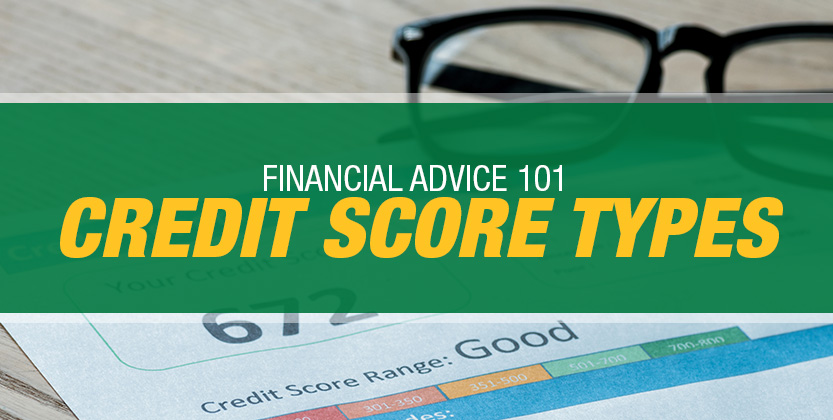
Credit Score Types Everyone Should Know and Why They Matter
These days, it’s hard to imagine not having to worry about your credit score when you make a major purchase. After all, it’s difficult to buy a home or vehicle, rent or buy a home, or even get a basic line of credit going without at least having a fair credit score. In some cases, a less-than-stellar credit score can even hamper a person’s ability to get a job.
Creditors expect potential borrowers to have well-established credit for virtually all types of loans. On the other hand, it’s almost impossible to even establish a line of credit without some kind of borrowing history.
Since you have to have credit to get credit, many people who have poor or nonexistent borrowing histories struggle to get anywhere. It’s often a vicious cycle that’s nearly impossible to break. To make matters worse, credit scores can be difficult to sort out and understand. Having more than one credit score further complicates the situation.
Where Did Credit Scores Come From?
Until about 50 years ago, credit scores didn’t really exist. Lenders largely doled out money based on their perceptions of prospective borrowers and their ability and likelihood to pay back loans. That wasn’t fair for borrowers or lenders. Many trustworthy prospects were unfairly rejected for loans. At the same time, lenders were commonly left in the lurch after granting loans to borrowers who weren’t as trustworthy as they initially seemed.
All that changed back in 1940 when the Fair Credit Reporting Act was passed, and FICO credit scores came into play. Since then, additional scores have also entered the mix. Of course, the tables turned in a different direction after all that, and many lenders came to rely solely on credit scores to determine which consumers were worthy borrowers.
Creating a More Borrower-Friendly World
Today, the lending world has become a bit more balanced. Some lenders are willing to look beyond credit scores to get an idea of the bigger picture. That means even people with low credit scores or limited borrowing histories can take advantage of bad credit loans to help kick-start or improve their credit.
Exploring the Different Types of Credit Scores
After a little digging, you may have noticed that you have more than one credit score lingering in the background of your borrowing adventures. That’s certainly normal because there are different credit bureaus, and they use different scoring models. Not all creditors report to all bureaus, and not all bureaus factor in the same types of information. With all that being said, let’s explore the wide world of credit scores.
FICO Scores
FICO, or the Fair Isaac Corporation, is the original credit bureau. It was established to help level the playing field for borrowers and lenders. Its numbers are also the most widely used credit scores among lenders.
FICO scores are based on five factors. These include how much money a person owes and the length of his or her borrowing history. FICO scores also factor in different types of credit, like loans and credit cards. They’re composed of how often a specific borrower applies for new lines of credit and his or her track record of payments on time as well.
In terms of credit scores, FICO breaks down its figures into five categories. Scores ranging from 300 to 579 are considered poor whereas those in the 580 to 669 range are fair. Good credit scores range from 670 to 739, and very good scores run from 740 to 799. Scores considered exceptional range from 800 to 850.
VantageScore
VantageScore is another popular scoring model. Different bureaus came together to create the VantageScore scale as an alternative to FICO. It also bases consumers’ credit scores on various factors. For one, it considers the amount of credit a consumer is currently using, how much available credit he or she has left, and the ratio between the two.
Secondly, VantageScore factors in the types of credit a person has and his or her experience with borrowing. Said debtor’s history of making payments on time and how long he or she has been building a credit history. His or her old credit accounts versus new ones are taken into consideration as well.
Based on VantageScore figures, those with a score of 300 to 499 are considered to have very poor credit. Consumers with a score of 500 to 600 have poor credit while those with scores of 601 to 660 have fair credit. Prospects with scores of 661 to 780 have good credit, and those in the 781 to 850 range have excellent credit.
Additional Considerations
Though VantageScore and FICO are the two most widely used scoring models, they’re not alone. FICO, for example, can generate different types of scores based on the companies making inquiries and the types of loans being considered. Some lenders also have their own unique in-house scoring models.
Understanding Different Types of Debt and Why Credit Scores Are Important
As you may already know, having a poor credit score can destroy your borrowing power. It can also leave you paying exorbitant interest rates on loans and credit cards. Having excellent or exceptional credit, on the other hand, can have the opposite effect.
Keep in mind, not all types of debt are equal. In the borrowing world, some types of debt are considered good while others are viewed as bad. Definitions vary when it comes to what distinguishes one from the other.
In general, though, good debt encompasses anything that could ultimately enhance your financial situation. This might include student, mortgage, and business loans. In contrast, bad debt includes having numerous credit cards and financial obligations you’re not paying back as promised.
Boosting Your Borrowing Power
Overall, everyone has more than one credit score. Those scores come from different bureaus and are calculated in different ways. People who have low credit scores or no borrowing history at all often struggle to acquire the loans they need.
If you’re struggling with bad credit, certain measures can aid in improving your credit scores. Be sure to monitor your credit and try to avoid debt that falls on the “bad” end of the spectrum. In contrast, a move like taking out a signature loan can help with building your credit and ramping up your borrowing power for the future.

